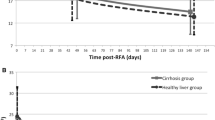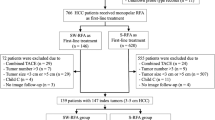Abstract
Purpose
To evaluate whether a new electrode embedded with an electromagnetic position sensor (EMPS) improves the technical feasibility of percutaneous radiofrequency ablation (RFA) in patients with hepatic tumors difficult to place an electrode under ultrasonography (US) guidance and to assess short-term therapeutic efficacy and safety.
Materials and Methods
This prospective study was approved by the institutional review board, and written informed consent was obtained from all patients. Between January 2015 and December 2016, 10 patients (7 men and 3 women; age range 52–75 years) with a single hepatic tumor (median 1.4 cm; range 1.1–1.8 cm) difficult to place an electrode under US guidance were enrolled. The technical feasibility of targeting and overlapping ablation during the RFA procedure was graded using a four-point scale and analyzed using the Wilcoxon signed rank test according to the use of EMPS. In addition, the rates of technical success, local tumor progression (LTP), and major complications were assessed.
Results
The use of the new RF electrode with EMPS significantly improved the technical feasibility of targeting and overlapping ablation (p = 0.002 and p = 0.003, respectively). After treatment, the technical success rate was 100%. LTP was not found in any patient during the follow-up period (median 8 months; range 4–22 months). No major procedure-related complications occurred.
Conclusions
The technical feasibility of percutaneous RFA improves with the use of this RF electrode embedded with an EMPS. Short-term therapeutic efficacy and safety after RFA using the electrode were promising in patients with hepatic tumors difficult to place an electrode under US guidance.



Similar content being viewed by others
Abbreviations
- CT:
-
Computed tomography
- EM:
-
Electromagnetic
- EMPS:
-
Electromagnetic position sensor
- HCC:
-
Hepatocellular carcinoma
- LTP:
-
Local tumor progression
- MRI:
-
Magnetic resonance imaging
- RFA:
-
Radiofrequency ablation
References
Forner A, Llovet JM, Bruix J. Hepatocellular carcinoma. Lancet. 2012;379(9822):1245–55.
Shady W, Petre EN, Gonen M, et al. Percutaneous radiofrequency ablation of colorectal cancer liver metastases: factors affecting outcomes—a 10-year experience at a single center. Radiology. 2016;278(2):601–11.
Lee MW. Fusion imaging of real-time ultrasonography with CT or MRI for hepatic intervention. Ultrasonography. 2014;33(4):227–39.
Kim J, Yoon CJ, Seong NJ, Jeong SH, Kim JW. Fluoroscopy-guided radiofrequency ablation for small hepatocellular carcinoma: a retrospective comparison with ultrasound-guided ablation. Clin Radiol. 2015;70(9):1009–15.
Rempp H, Unterberg J, Hoffmann R, et al. Therapy monitoring of magnetic resonance-guided radiofrequency ablation using T1- and T2-weighted sequences at 1.5 T: reliability of estimated ablation zones. Invest Radiol. 2013;48(6):429–36.
Mulier S, Ni Y, Jamart J, Ruers T, Marchal G, Michel L. Local recurrence after hepatic radiofrequency coagulation: multivariate meta-analysis and review of contributing factors. Ann Surg. 2005;242(2):158–71.
Kim YS, Lee WJ, Rhim H, Lim HK, Choi D, Lee JY. The minimal ablative margin of radiofrequency ablation of hepatocellular carcinoma (>2 and <5 cm) needed to prevent local tumor progression: 3D quantitative assessment using CT image fusion. AJR Am J Roentgenol. 2010;195(3):758–65.
Minami Y, Chung H, Kudo M, et al. Radiofrequency ablation of hepatocellular carcinoma: value of virtual CT sonography with magnetic navigation. AJR Am J Roentgenol. 2008;190(6):W335–41.
Song KD, Lee MW, Rhim H, Cha DI, Chong Y, Lim HK. Fusion imaging-guided radiofrequency ablation for hepatocellular carcinomas not visible on conventional ultrasound. AJR Am J Roentgenol. 2013;201(5):1141–7.
Appelbaum L, Mahgerefteh SY, Sosna J, Goldberg SN. Image-guided fusion and navigation: applications in tumor ablation. Tech Vasc Interv Radiol. 2013;16(4):287–95.
Min JH, Lim HK, Lim S, et al. Radiofrequency ablation of very-early-stage hepatocellular carcinoma inconspicuous on fusion imaging with B-mode US: value of fusion imaging with contrast-enhanced US. Clin Mol Hepatol. 2014;20(1):61–70.
Hakime A, Deschamps F, De Carvalho EG, Barah A, Auperin A, De Baere T. Electromagnetic-tracked biopsy under ultrasound guidance: preliminary results. Cardiovasc Interv Radiol. 2012;35(4):898–905.
Jung EM, Friedrich C, Hoffstetter P, et al. Volume navigation with contrast enhanced ultrasound and image fusion for percutaneous interventions: first results. PLoS ONE. 2012;7(3):e33956.
Tomonari A, Tsuji K, Yamazaki H, et al. Feasibility of the virtual needle tracking system for percutaneous radiofrequency ablation of hepatocellular carcinoma. Hepatol Res. 2013;43(12):1352–5.
Kang TW, Lee MW, Choi SH, et al. A novel electrode with electromagnetic tip tracking in ultrasonography-guided radiofrequency ablation: a phantom, ex vivo, and in vivo experimental study. Invest Radiol. 2015;50(2):81–7.
Ahmed M, Solbiati L, Brace CL, et al. Image-guided tumor ablation: standardization of terminology and reporting criteria—a 10-year update. Radiology. 2014;273(1):241–60.
Rhim H, Choi D, Kim YS, Lim HK, Choe BK. Ultrasonography-guided percutaneous radiofrequency ablation of hepatocellular carcinomas: a feasibility scoring system for planning sonography. Eur J Radiol. 2010;75(2):253–8.
Lee MW, Rhim H, Cha DI, Kim YJ, Lim HK. Planning US for percutaneous radiofrequency ablation of small hepatocellular carcinomas (1–3 cm): value of fusion imaging with conventional US and CT/MR images. J Vasc Interv Radiol. 2013;24(7):958–65.
Kang TW, Lim HK, Lee MW, et al. Long-term therapeutic outcomes of radiofrequency ablation for subcapsular versus nonsubcapsular hepatocellular carcinoma: a propensity score matched study. Radiology. 2016;280(1):300–12.
Kang TW, Lim HK, Lee MW, Kim YS, Choi D, Rhim H. Perivascular versus nonperivascular small HCC treated with percutaneous RF ablation: retrospective comparison of long-term therapeutic outcomes. Radiology. 2014;270(3):888–99.
Kang TW, Lim HK, Lee MW, Kim YS, Choi D, Rhim H. First-line radiofrequency ablation with or without artificial ascites for hepatocellular carcinomas in a subcapsular location: local control rate and risk of peritoneal seeding at long-term follow-up. Clin Radiol. 2013;68(12):e641–51.
Venkatesan AM, Kadoury S, Abi-Jaoudeh N, et al. Real-time FDG PET guidance during biopsies and radiofrequency ablation using multimodality fusion with electromagnetic navigation. Radiology. 2011;260(3):848–56.
Krucker J, Xu S, Venkatesan A, et al. Clinical utility of real-time fusion guidance for biopsy and ablation. J Vasc Interv Radiol. 2011;22(4):515–24.
Nakazawa T, Kokubu S, Shibuya A, et al. Radiofrequency ablation of hepatocellular carcinoma: correlation between local tumor progression after ablation and ablative margin. AJR Am J Roentgenol. 2007;188(2):480–8.
Hakime A, Barah A, Deschamps F, et al. Prospective comparison of freehand and electromagnetic needle tracking for US-guided percutaneous liver biopsy. J Vasc Interv Radiol. 2013;24(11):1682–9.
Dodd GD 3rd, Frank MS, Aribandi M, Chopra S, Chintapalli KN. Radiofrequency thermal ablation: computer analysis of the size of the thermal injury created by overlapping ablations. AJR Am J Roentgenol. 2001;177(4):777–82.
Acknowledgements
The authors thank Mr. Joon Hyok Lee (STARmed, Goyang, South Korea) for his technical assistance.
Financial Support
Financial support and the investigational RF ablation device for this study were provided by STARmed (Goyang, Korea). However, the authors had complete control of the data and information submitted for publication, which was unbiased by the industry.
Author information
Authors and Affiliations
Corresponding author
Ethics declarations
Conflict of interest
The authors do not have any conflicts of interest to declare.
Electronic supplementary material
Below is the link to the electronic supplementary material.
Supplementary material 1 (WMV 7289 kb)
Rights and permissions
About this article
Cite this article
Kang, T.W., Lee, M.W., Song, K.D. et al. Ultrasound-Guided Radiofrequency Ablation Using a New Electrode with an Electromagnetic Position Sensor for Hepatic Tumors Difficult to Place an Electrode: A Preliminary Clinical Study. Cardiovasc Intervent Radiol 40, 1891–1898 (2017). https://doi.org/10.1007/s00270-017-1751-9
Received:
Accepted:
Published:
Issue Date:
DOI: https://doi.org/10.1007/s00270-017-1751-9




